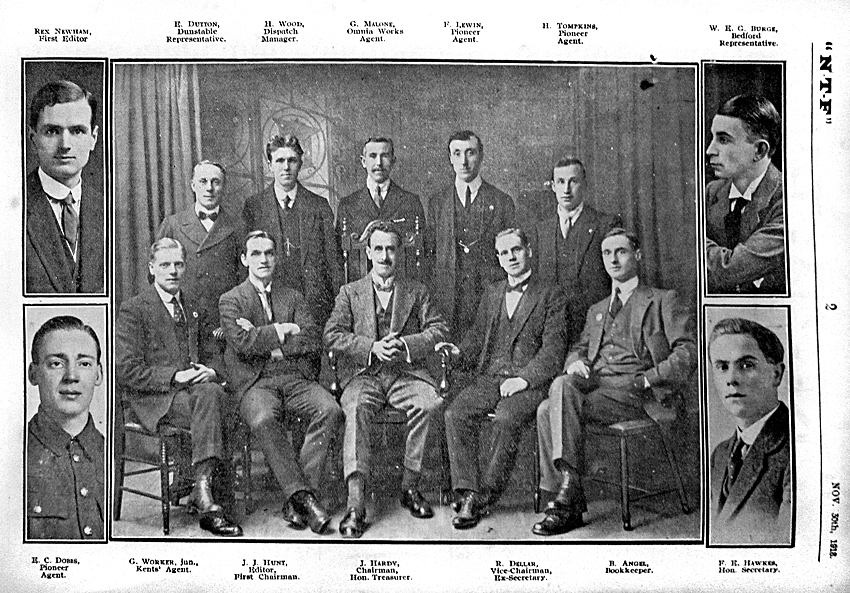Objects and Places

This page contains a list of Objects and Places that are associated with Luton's Great War 1914-1918. They have been scanned/photographed and uploaded by project volunteers and members of the public. Many of these objects are linked to individuals and/or events, and form part of a larger story.
|
|
“C” BATTERY NO. 6 RESERVE BRIGADE, R.F.A., (T) WAR DIARY |
|
|
NO. 6 RESERVE BRIGADE ARTILLERY WAR DIARY BISCOT CAMP, LUTON |
|
|
NO. 6 RESERVE BRIGADE ARTILLERY WAR DIARY BISCOT CAMP, LUTON |
|
|
NO. 6 RESERVE BRIGADE ARTILLERY WAR DIARY BISCOT CAMP, LUTON |
|
|
NO. 6 RESERVE BRIGADE ARTILLERY WAR DIARY BISCOT CAMP, LUTON |

The Duke of Bedford created a showpiece military training camp for the Bedfordshire Regiment at Ampthill Park - and Luton men were among the first 300 to experience what The Luton News described as "the place" for recruits.

The period immediately before, during, and just after World War One was a defining time for local newspaper The Luton News. From small beginnings in 1891 it had grown into the most widely read local publication in the town.

Although Wardown House was opened as a military hospital for wounded troops, hundreds of soldiers were still treated along with civilians at the Bute Hospital in Dunstable Road during World War One, greatly adding to its workload.
Luton Hoo, country home of Lady Alice Wernher, played a crucial role in World War One. From the outset it became a military headquarters, and was also used as a convalescent home for officers.

A memorial plaque to the men who lost their lives in the Great War.
Hedley Angel
Albert Barton
John Vincent Blackburn

Images of the names of the fallen from the Bedfordshire Regiment remembered on the Tyne Cot Memorial, Zonnebeke, Belgium.
On 21st August 1916 The Luton News published a full page memorial to the men of 5th Battalion Bedfordshire Regiment.

Stopsley War Memorial, commemorating the 24 men of the village who fell in the Great War, was unveiled by Mr Ben Hartop on March 27th, 1921, in front of a crowd of several hundred people.

Leagrave War Memorial, a monument to the men of Leagrave, Limbury and Biscot who gave their lives in World War One, was unveiled on the afternoon of Sunday, July 24th, 1921, by Lady Ludlow, of Luton Hoo, in front of a large crowd of people.

As a prominent landmark on Market Hill it was inevitable that the Corn Exchange should become a focus for recruiting during World War 1.

Like the Corn Exchange, the Plait Halls were to play an important role in World War 1 Luton, first as a requisitioned storage point and then, from March 1915 in the case of the Waller Street hall, as a YMCA recreation centre for soldiers billeted in the town.
Diary of Events
For more information about the various Regiments and the events at Gallipoli read 'British Regiments at Gallipoli' by Ray Westlake, published by Leo Cooper, London ISBN 0 85052 511 X

The new Waller Street baths proved a popular attraction with troops billeted in Luton, particularly in the early months of the war. Thousands took advantage of the facilities both for recreational swimming and half-price use of the slipper baths for hygiene.

George Kent Ltd, based in Biscot Road, Luton, was one of several firms in the town to gear its production to the war effort between 1914 and 1919.

World War One was to be a time of expansion and increasing profits for Vauxhall Motors Ltd, who arrived in the town in 1905 from London in need of larger premises and with the prospect of a ready and cheap power supply from Luton Electricity Works, opened in 1901.
With the outbreak of World War One the whole of the output of the Commer Cars Ltd factory in Biscot Road, Luton - opened in July 1906 - was commandeered by the War Department.

Private George Marlow of the 2nd Batallion Bedfordshire Regiment sent Christmas greetings from France to his younger brother Horace .

Private George Marlow of the 2nd Batallion Bedfordshire Regiment sent this postcard from France to his father Frederick.

This book belonged to Private George Marlow of the 2nd Battalion Bedfordshire Regiment.
As part of their official documents, all soldiers serving in the Great War were issued with a Pay Book.

- British Gelatine Works in New Bedford Road shortly after opening. A Chamber of Commerce report in February 1903 said the works were by then in full swing.

Meet the Biscot Camp Pierrot Troupe. They had become one of the most popular entertainment groups in Luton during 1916, appearing at halls around the town to raise money for comforts for their fighting comrades at the Front.

This letter was sent from Buckingham Palace in 1918 to a repatriated prisoner of war. It was one of copies that were probably received by thousands of men all over the country.

Memorial to the 34 employees of the Sundon Cement and Lime Works who gave their lives in World War One. The memorial is now attached to the exterior of St Mary's Church, Lower Sundon. The men commemorated are:
Sgt William Hyde (7th Beds - July 2nd, 1916)

Luton has always been proud of its Red Cross Band, said The Luton News (May 31, 1917) in the week it printed pictures of 20 bandsmen who had joined the Colours.

As a person, seaman Austin J. Small seems something of an enigma. But as a poet he had a powerful way with words. He first appeared on the scene in his latter capacity with a poem entitled "Destroyers" which was published in The Luton News on March 15th, 1917.

This official acknowledgement of the role played by Wardown House in the care given to sick and wounded soldiers during World War One hung near the entrance in the years following the conflict.







